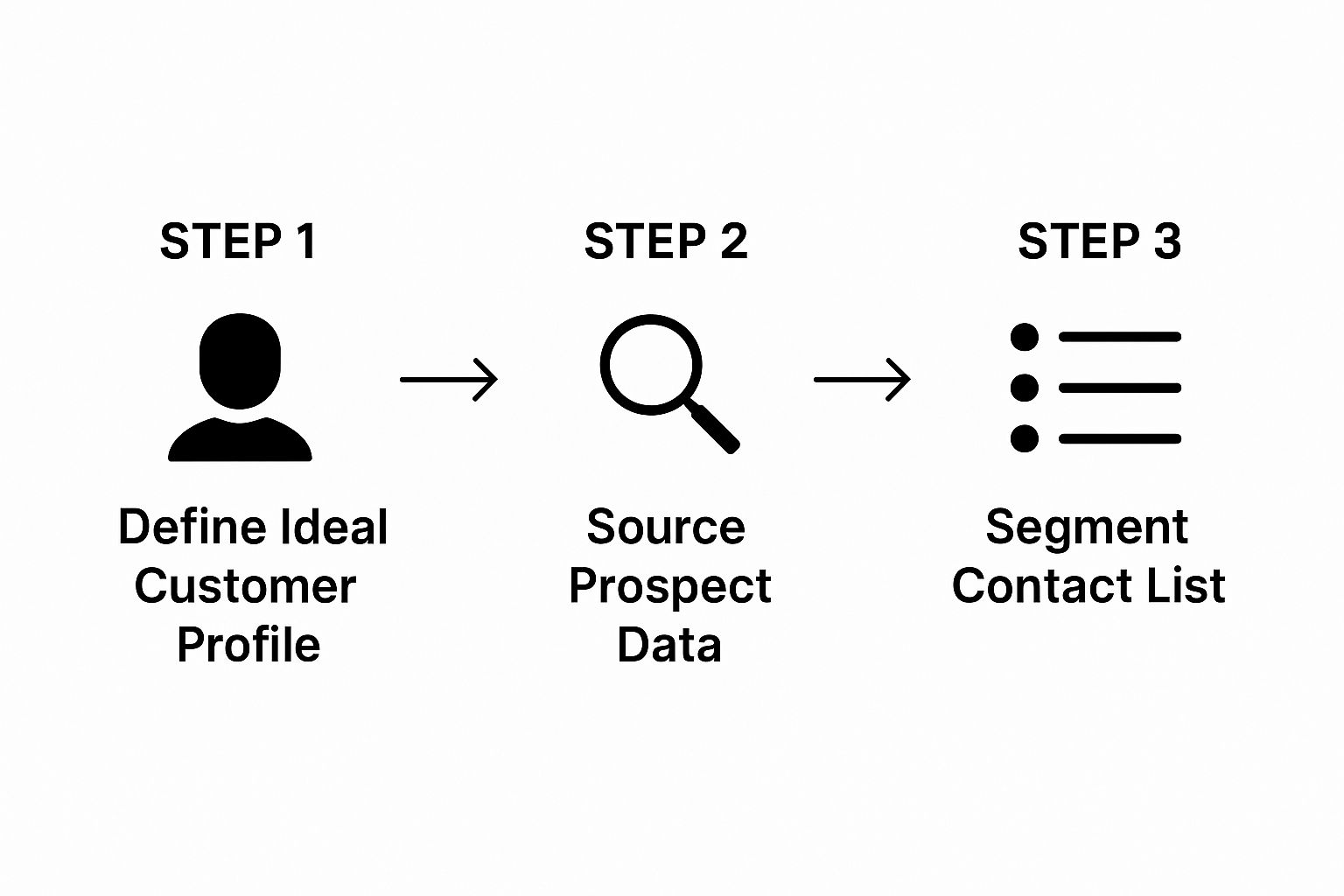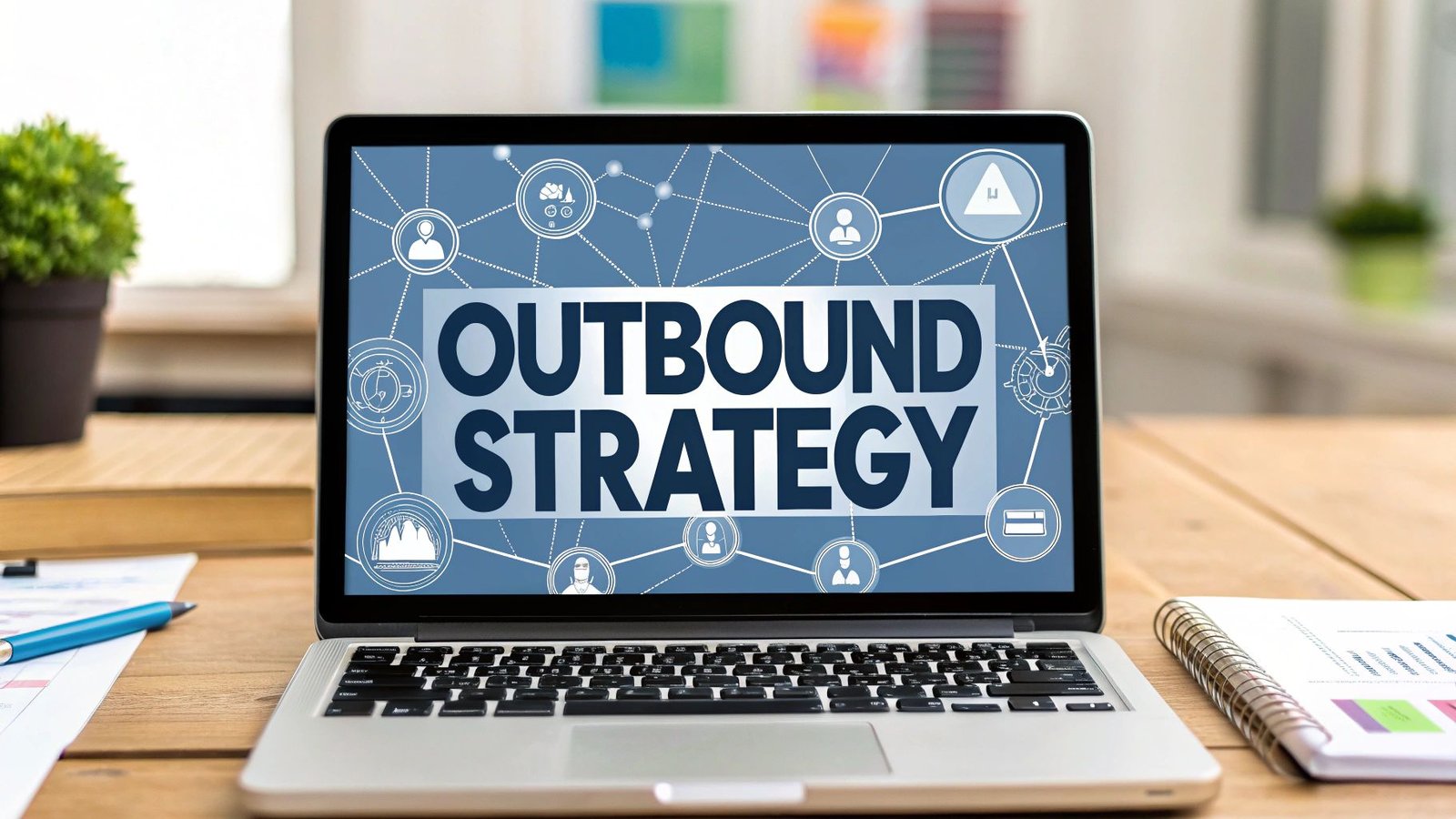Outbound lead generation is all about taking the initiative. Instead of waiting for potential customers to find their way to your digital doorstep, you proactively reach out to them. This means using channels like cold email, social selling, and strategic calling to spark conversations with a carefully chosen audience.
Unlocking Growth with Outbound Lead Generation

Think of inbound marketing as setting up an amazing shop on a busy street. You have great window displays (your content) and clear signage (your SEO) to attract people who are already walking by and looking for something you offer. It’s effective, but you're reliant on foot traffic.
Outbound lead generation is different. It’s like being a skilled artisan who doesn’t just wait for customers to wander into their workshop. Instead, you actively identify and seek out the specific collectors and connoisseurs who would truly appreciate your craft. You go to them, build relationships, and showcase your work to a handpicked audience.
This proactive approach is the heart and soul of a modern outbound strategy. It's not about casting a wide, indiscriminate net; it’s about precision, relevance, and starting meaningful conversations.
Inbound vs Outbound Lead Generation At a Glance
To put it simply, inbound and outbound are two sides of the same growth coin. One pulls, the other pushes. This table breaks down the core differences at a high level.
| Characteristic | Inbound Lead Generation | Outbound Lead Generation |
|---|---|---|
| Initiation | Customer initiates contact (e.g., finds you via search). | You initiate contact (e.g., send a cold email). |
| Approach | Attracts with valuable content (pulls leads in). | Seeks out specific targets (pushes messaging out). |
| Audience | Broad, targeting anyone with a relevant problem. | Narrow, targeting a pre-defined Ideal Customer Profile. |
| Time to Results | Slower, builds momentum over time. | Faster, can generate conversations and meetings quickly. |
| Control | Less direct control over lead volume and quality. | High control over targeting and activity volume. |
Each has its place, and the most successful companies learn to blend both strategies to create a robust and resilient growth engine.
Why Proactive Outreach Matters
The goal of outbound is to connect with your ideal customers, even if they aren't actively looking for a solution right now. You identify companies that match your Ideal Customer Profile (ICP), find the right decision-makers within those companies, and start a conversation based on a solid understanding of their likely challenges.
This is a world away from the old "spray and pray" tactics that gave cold outreach a bad name. Today's successful outbound is built on a foundation of:
- Personalization: Messages that speak directly to a prospect’s specific role, company, and industry pain points.
- Value-First Approach: Offering genuine insights or helpful resources before you ever ask for a meeting.
- Strategic Targeting: Focusing all your team's energy on the prospects who stand to gain the most from your product.
By proactively engaging your target market, you take control of your sales pipeline. You're no longer just waiting for leads to trickle in; you're building a predictable and scalable engine for revenue growth.
The Engine for Predictable Revenue
For B2B and SaaS companies, this level of control is a game-changer. While a strong inbound strategy builds a fantastic long-term foundation, a well-executed outbound plan often delivers more immediate and predictable results. It gives your sales team direct influence over how many quality conversations they start each week.
When done right, outbound lead generation becomes a powerful, reliable driver of business expansion. It fills your sales funnel with high-quality, pre-qualified prospects and perfectly complements your inbound efforts, creating a complete and unstoppable growth ecosystem.
Building Your High-Impact Outbound Strategy
A winning outbound program doesn’t just happen. It’s built, piece by piece, on a solid foundation. You wouldn't start putting up walls on a new building without first pouring the concrete and setting the steel frame, right? In the same way, you can't just start firing off emails without a clear, deliberate plan.
That blueprint starts with one fundamental question: who, exactly, are you trying to reach? A powerful outbound machine is a focused one, channeling all its energy toward prospects who are a perfect fit for what you offer.
Define Your Ideal Customer Profile
Before you write a single line of email copy or pull any contact list, you have to nail down your Ideal Customer Profile (ICP). Think of your ICP as a detailed sketch of the perfect company to buy your product. This goes way beyond just their industry or employee count; it’s about the specific traits that scream "this is a great potential partner."
Here’s an analogy: a hobbyist fisherman might cast a wide net, hoping to catch anything that swims by. But a professional outbound team? They use a specific lure, designed to attract a specific type of fish, in a very specific part of the lake. Your ICP is that specialized lure.
To build a solid ICP, get your team together and answer questions like these:
- Firmographics: What industry are they in? What’s their company size, both in revenue and employee count? Where are they located?
- Technographics: What technology stack are they running? Are they using a specific tool that signals a need for your solution?
- Trigger Events: Did they just get a round of funding? Hire a new VP of Sales? Announce a big expansion? These are buying signals.
Nailing this down is the single most important step in any lead generation outbound campaign. Without it, you’re flying blind. For a deeper dive, our guide on how to identify target customers for your business is a great resource.
This visual breaks down the simple but powerful flow from defining your ideal customer to segmenting them for outreach that actually works.

Following this process ensures every move you make is laser-focused on finding and engaging the right accounts.
Build High-Quality Prospect Lists
Once you have a crystal-clear ICP, the next step is finding the actual companies and people who match it. This is where you build your prospect list—the fuel for your entire outbound engine. You’ve really got two main ways to go about this.
- Data Providers: Tools like ZoomInfo, Apollo.io, or our own Nordic Lead Database are treasure troves of company and contact data. You can filter their massive databases using your ICP criteria to quickly build lists at scale.
- Manual Research: For super-targeted campaigns or when you're going after whale-sized accounts, nothing beats manual research. Getting on LinkedIn Sales Navigator and doing the digging yourself is slower, but the data quality is often much higher.
Honestly, the best strategies use a mix of both. Use data providers to build the bulk of your list, then use manual research to enrich the data for your top-tier prospects and find those golden personalization nuggets. A clean, accurate list is completely non-negotiable.
Craft Compelling and Personalized Messages
Okay, so you know who you're reaching out to and you have their contact info. Now for the moment of truth: what are you going to say? This is where so many outbound efforts fall flat. A generic, self-serving message will be ignored or marked as spam nearly 100% of the time.
Your goal isn’t to pitch your product. It’s to start a conversation.
The secret to a great message is making it about them, not you. Center it on their problems, their industry, their recent wins. Show them you've actually done your homework.
Here are a few tips for writing outreach that actually gets replies:
- Lead with Relevance: Your very first sentence needs to answer the question, "Why me?" Mention a recent company announcement, a post they shared, or a mutual connection.
- Talk Problems, Not Features: Don’t just list what your product does. Talk about a common pain point for someone in their role and hint at a better way to solve it.
- Keep It Short and Scannable: Busy people don't read novels in their inbox. Use short sentences, short paragraphs, and a clear call-to-action.
- End with a Low-Friction Ask: Instead of a demanding "Can I have 30 minutes of your time?", try something softer, like, "Is solving [problem] a priority for you right now?"
Proven Outbound Channels and Tactics That Work

Alright, you've got a solid strategy mapped out. Now it's time to get your hands dirty and put that plan into action. Picking the right outbound channels is a bit like a chef choosing their knives—each one has a specific job and excels at a particular task.
The truth is, the most successful outbound programs almost never lean on a single channel. The real secret sauce is blending several tactics into a coordinated sequence. This creates multiple, well-timed opportunities to connect with the people you want to talk to, meeting them where they're most active.
Mastering Personalized Cold Email
Cold email is still the king of outbound sales for a few simple reasons: it's direct, it's scalable, and when you do it right, it works incredibly well. But we need to forget the generic, mass-blasted emails from a decade ago. Success today is all about deep personalization and delivering real value from the very first sentence.
The key is to go way beyond just slotting in a {first_name} and {company_name}. True personalization means referencing something specific, like a recent LinkedIn post they wrote, a company milestone they just announced, or a challenge you know is common in their industry. It shows you’ve actually done your homework.
The goal of a cold email isn't to sell your product. It's to sell the next step—whether that’s a brief conversation, a reply, or a click on a valuable resource.
Despite its power, a recent survey showed that only 18% of marketers feel their outbound efforts generate high-quality leads. Yet, email remains the most common tool in the shed, with about 78% of businesses using it. This just goes to show how effective it can be when you approach it thoughtfully.
Engaging Prospects with Social Selling
Platforms like LinkedIn have become the new town square for B2B sales. But social selling isn't about carpet-bombing inboxes with generic connection requests and sales pitches. It’s a long game, focused on building rapport, establishing yourself as an expert, and having genuine conversations over time.
Think of it like networking at an industry conference. You wouldn't just walk up to a CEO, shove a business card in their face, and launch into your pitch. You'd start a conversation, find some common ground, and offer a helpful insight.
Here are a few ways to do that effectively online:
- Meaningful Engagement: Don't just "like" a prospect's post. Drop a thoughtful comment that adds to the conversation and subtly showcases your expertise.
- Personalized Connection Requests: Always add a short note explaining why you want to connect. Maybe you have a mutual connection, share a group, or really enjoyed a piece of content they shared.
- Value-Driven Content Sharing: Post articles, case studies, and insights that speak directly to your ideal customer's pain points. This positions you as a helpful advisor, not just another salesperson.
This strategy builds familiarity and trust. So, when you finally do slide into their DMs, your name will already ring a bell.
Reframing Strategic Cold Calling
Let's be honest, "cold calling" often brings to mind images of aggressive telemarketers reading from a stiff script. But a modern, strategic cold call is a completely different beast. It's a powerful tool for cutting through the digital clutter and making a real human connection.
A well-timed call can accomplish in 30 seconds what a dozen emails can't. The key is to be prepared, be respectful of their time, and focus on discovery, not just pitching.
Today's successful cold call is less of a hard sell and more of a quick, value-focused conversation starter. It's your chance to ask smart questions, uncover a potential need, and quickly figure out if there's a good fit. To really sharpen your team's skills, digging into some cold calling best practices can give you the scripts and frameworks needed to win.
Integrating Channels in a Multi-Touch Cadence
This is where the real magic happens. You start weaving these individual channels together into a cohesive, multi-touch cadence. A cadence is simply a pre-planned series of outreach attempts across different platforms over a set period.
This approach keeps you on their radar without being annoying. A well-designed sequence might look something like this:
- Day 1: Personalized Email #1
- Day 1: LinkedIn Profile View
- Day 3: LinkedIn Connection Request (with a personalized note)
- Day 5: Follow-up Email #2 (as a reply to the first)
- Day 7: Strategic Phone Call
- Day 8: Engage with their latest LinkedIn Post
- Day 10: Final Email (the "breakup" message)
By mixing automated emails with manual social touches and direct calls, you create a persistent and professional campaign that dramatically increases your odds of sparking a real sales conversation.
Essential Tools for Your Outbound Tech Stack
A killer outbound strategy is more than just clever messaging and a nailed-down ICP. It runs on a powerful, well-integrated technology stack.
Think of it like a professional chef's kitchen. You have different stations—prep, cooking, plating—and each needs specialized tools that work together seamlessly. Your outbound tech stack is no different. Each piece of software has a specific job to do in building an efficient lead generation machine.
Without the right tools, even the best strategy will collapse under the weight of manual, repetitive tasks. Your team would spend more time logging data and hunting for information than actually selling. The right technology automates the busywork, helps you scale your outreach, and gives you the data needed to make every campaign better than the last.
The CRM: Your Central Nervous System
At the heart of any modern sales operation is the Customer Relationship Management (CRM) system. This is your central database, the single source of truth for every single prospect and customer interaction. Platforms like Salesforce or HubSpot act as the command center, connecting every other tool and action into one cohesive system.
Your CRM does way more than just store contact info. It tracks every email sent, call made, and meeting booked. This gives your entire team a complete, 360-degree view of the customer relationship, which is absolutely critical for personalizing your follow-ups and keeping the conversation relevant.
Sales Engagement Platforms for Orchestrated Outreach
If the CRM is the brain, then a Sales Engagement Platform (SEP) is the conductor of your outbound orchestra. Tools like Outreach, SalesLoft, or Reply.io are built to help your team execute multi-channel, multi-step outreach sequences at scale. An SEP automates the nitty-gritty of sending personalized emails, scheduling calls, and dropping reminders for social media touchpoints.
This is the engine that drives your cadence. Instead of manually tracking who to email or call next, your sales reps can focus on high-value activities, like crafting that perfect personalization or having a real conversation. A well-configured SEP ensures no prospect ever falls through the cracks.
An integrated tech stack transforms your outbound efforts from a series of disjointed actions into a streamlined, data-driven process. The goal is to empower your sales reps to spend less time on administration and more time building relationships.
Prospecting and Data Enrichment Tools
You can't start a conversation if you don't know who to talk to. This is where prospecting and data enrichment tools come in. Platforms like ZoomInfo, Apollo.io, or our own Nordic Lead Database provide the fuel for your lead generation outbound engine: accurate B2B contact and company data.
These tools help you build hyper-targeted prospect lists based on your ideal customer profile. They give you the essentials—verified emails, direct-dial phone numbers—but also crucial firmographic data that makes your outreach possible. Many are now offering "intent data," which can signal when a company is actively researching solutions like yours, giving you the perfect opening.
Integrating these systems is what separates the pros from the amateurs. When you build a list in Apollo.io, it should sync directly into your SEP to be enrolled in a sequence, and every touchpoint should automatically log back to the master record in your CRM. This creates a flawless flow of information.
You can learn more about connecting all the dots by reading our guide on the sales automation process. With these core components in place, your team has the foundation needed to run a world-class outbound strategy.
Measuring Success with Outbound Metrics That Matter

Running an outbound campaign without tracking the right numbers is like flying a plane without instruments. Sure, you’re moving, but are you gaining altitude or heading for a nosedive? To really know what’s working, you have to focus on the metrics that actually signal progress.
It’s easy to get distracted by "opens" and "clicks." We call those vanity metrics—they look impressive on a report but don't tell you much about generating real revenue. A smart lead generation outbound strategy measures what happens at every step of the sales journey, giving you the data you need to make better decisions.
Top of Funnel Engagement Metrics
This is your first reality check. These metrics tell you if your outreach is even getting noticed by the right people. Think of them as the early warning system for your entire campaign.
Here's what to watch closely:
- Deliverability Rate: What percentage of your emails actually made it to the inbox? If this number drops below 95%, you have a problem. It could be your email list or a damaged sending reputation, but either way, it needs fixing fast.
- Reply Rate: This is the big one at the top of the funnel. It’s the percentage of people who hit "reply." A strong reply rate means your message resonated enough for someone to stop what they were doing and engage.
If your reply rate is in the gutter, it’s a clear signal to go back to the drawing board. You’ve either got the wrong audience, a weak list, or a message that just isn't compelling.
Mid Funnel Conversion Metrics
Okay, so you got a reply. Now what? The game shifts from getting attention to creating real sales opportunities. Mid-funnel metrics are all about tracking how well your team turns that initial spark of interest into a qualified meeting.
Measuring the right KPIs is about diagnosing problems before they derail your pipeline. If reply rates are high but meetings booked are low, you know the issue isn't your messaging—it's what happens after the prospect responds.
The most important numbers to track here are:
- Positive Reply Rate: Not all replies are created equal. This metric filters out the polite "no thank yous" and focuses on the percentage of replies that show genuine interest. It tells you how many real conversations you're starting.
- Meetings Booked: This is where the rubber meets the road. How many demos or discovery calls did your campaign actually generate? For most outbound teams, this is the primary goal.
- Sales Qualified Leads (SQLs): This takes it a step further. An SQL is a booked meeting that has been vetted and confirmed as a legitimate opportunity for your pipeline. It proves you’re talking to the right people, not just anyone who will take a call.
Watching these metrics is how you demonstrate the real ROI of your outbound efforts. You can draw a straight line from your team's activity to pipeline growth, proving the value of your strategy and giving you the confidence to double down on what works. This is how you stop guessing and start making data-driven decisions.
Real-World Examples of Outbound Success
Theory is one thing, but seeing how these strategies play out in the real world is where it all clicks. Smart lead generation outbound isn't just a list of tactics; it’s a powerful growth engine, but only when you execute it with real precision.
Let's walk through a common scenario. Imagine a B2B SaaS company that has poured resources into creating fantastic content—think in-depth whitepapers and detailed industry reports. These are valuable assets, but just letting them sit on a website waiting for inbound traffic is a huge missed opportunity. A simple shift to a proactive outbound model can completely change the game.
Combining Inbound Assets with Outbound Outreach
Instead of just hoping for downloads, the sales team gets proactive. They pinpoint 500 companies that are a dead-on match for their Ideal Customer Profile. From there, they build a multi-touch sequence designed to lead with value, not a hard sales pitch.
-
Step 1: The first touch is an email. It doesn't just say "Hey, buy our stuff." Instead, it points out a specific challenge happening in the prospect's industry and offers a link to their new whitepaper as a genuinely helpful resource.
-
Step 2: A few days later, they send a personalized LinkedIn connection request. The message mentions a key statistic or insight from that same whitepaper, making the connection relevant.
-
Step 3: The final step might be a brief call. Again, the goal isn't to sell. It’s to ask a simple question: "Did any of the insights in that report hit home for you?"
This blended approach transforms a passive content library into an active conversation starter. It shows respect for the prospect's time by offering value upfront, which naturally opens the door for a real sales discussion later. The result? A significant jump in qualified demos booked.
The most powerful outbound strategies don't operate in a vacuum. They amplify the value of existing marketing assets by proactively delivering them to the people who need them most.
This synergy is where companies see a real impact on their bottom line. For example, one software company combined their webinar assets with outbound outreach on LinkedIn and cold email, leading to a 28% increase in quarterly sales. Another B2B firm added cold calls and event sponsorships to their existing content strategy and managed to shorten their sales cycle by 20%. You can explore more about how these strategies drive tangible results at martal.ca.
Here’s another great example from a B2B service firm. They use event-based prospecting by keeping a close eye on industry trade shows and conferences. Before an event even starts, their team identifies key attendees and reaches out to schedule brief meetings in advance. This simple move turns a chaotic networking free-for-all into a series of highly qualified, pre-vetted conversations. It just goes to show that a smart outbound plan can speed up client acquisition in almost any setting.
Outbound Strategy FAQs: Your Questions, Answered
As you start putting your outbound strategy into motion, you're bound to run into some questions. It's completely normal. Getting the details right on outreach, compliance, and your overall approach is what separates the short-term wins from long-term, predictable growth.
Let's tackle some of the most common questions we hear from sales teams who are in the exact same spot you are. This is your go-to guide for those "am I doing this right?" moments.
How Much Outreach Is Actually Too Much?
This is the big one, isn't it? Everyone wants a magic number, but the real answer is about a core principle: are you giving value, or just asking for their time?
As a starting point, a well-paced cadence of 7-10 touches across different channels over two or three weeks is a solid benchmark. The key is that if your messages are genuinely helpful and relevant to their world, prospects rarely feel spammed.
But bombarding someone with five generic "just checking in" emails in a week? That's definitely too much. The trick is to mix it up—use email, then LinkedIn, maybe a call—and make sure every single touchpoint offers a fresh perspective or a useful piece of information.
The line between persistence and pestering is drawn by the value you provide. If every interaction is all about you, even a few touches will feel like too many. If you're consistently helpful, you earn the right to be persistent.
Is Cold Calling Dead?
Not even close. But the old-school way of doing it? That’s definitely dead. The days of grabbing a phone book and just "smiling and dialing" are long over, and for good reason.
Today, a strategic cold call is an incredible way to cut through all the digital noise and make a real human connection. It's not about calling completely out of the blue. It’s about being smart.
For example, a call becomes much "warmer" if you place it right after a prospect opens your email or views your LinkedIn profile. It works because you now have a specific, relevant reason to be reaching out, which instantly changes the dynamic of the conversation.
What's The Single Best Channel For Outbound Leads?
Sorry to disappoint, but there isn't one. The "best" channel is wherever your Ideal Customer Profile (ICP) actually spends their time. The most powerful strategies are almost always a mix of channels working together.
- Selling to Tech Executives? You'll likely find that a blend of highly personalized emails and thoughtful LinkedIn engagement is your sweet spot.
- Targeting Manufacturing Managers? A combination of email and well-timed phone calls often gets the best results here.
- Trying to reach Creative Directors? Think visually. LinkedIn is great, but don't rule out creative, targeted direct mail to really stand out.
Use email as your home base since it's easy to scale. Then, start layering in the other channels where your specific audience hangs out. Test, measure, and let the results tell you where to double down.
Ready to stop guessing and start connecting with the right people? The Nordic Lead Database gives you the most accurate and in-depth B2B contact data for the entire Nordic region. It's the fuel your team needs to build a powerful and predictable outbound engine. Find your next customer today.
